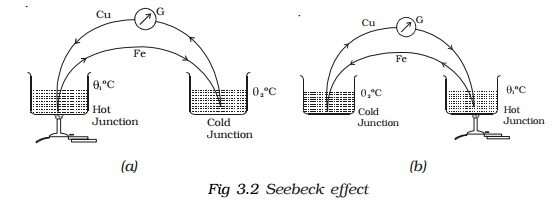Chapter: physics 11th 12th standard school college definition answer assignment examination viva question
Seebeck effect

Seebeck effect
In 1821, German Physicist Thomas Johann Seebeck discovered that in a circuit consisting of two dissimilar metals like iron and copper, an emf is developed when the junctions are maintained at different temperatures.
Two dissimilar metals connected to form two junctions is called thermocouple. The emf developed in the circuit is thermo electric emf. The current through the circuit is called thermoelectric current. This

effect is called thermoelectric effect or Seebeck effect. If the hot and cold junctions are interchanged, the direction of current also reverses. Hence Seebeck effect is reversible. In a Cu-Fe thermocouple (Fig 3.2a), the direction of the current is from copper to iron at the hot junction (Fig 3.2b).
The magnitude and sign of thermo emf depends on the materials of the two conductors and the temperatures of the hot and cold junctions. Seebeck after studying the thermoelectric properties of different pairs of metals, arranged them in a series called thermoelectric series. The direction of the current at the hot junction is from the metal occurring earlier in the series to the one occurring later in the series. The magnitude of thermoemf is larger for metals appearing farther apart in the series. The thermo-electric series of metals is :
Bi, Ni, Pd, Pt, Cu, Mn, Hg, Pb, Sn, Au, Ag, Zn, Cd, Fe, Sb.
The position of the metal in the series depends upon the temperature. The thermoemf of any thermocouple has the temperature dependence given by the relation,
V = α θ + ½ β θ2,
where θ is the temperature difference between the junctions and α and β are constants depending on the nature of the materials.
Related Topics